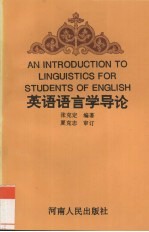

英语语言学导论PDF电子书下载
- 电子书积分:9 积分如何计算积分?
- 作 者:张克定编著
- 出 版 社:郑州:河南人民出版社
- 出版年份:1991
- ISBN:7215018288
- 页数:191 页
Ⅰ.Language and Iinguistics 1
1.Language 1
1.1 What is language? 1
1.2 The key properties of human language 3
2.Linguistics 8
2.1 What is linguistics? 8
2.2 Distinctions between linguistics and traditional grammar 8
2.3 The scope of linguistics 11
2.4 Synchronic and diachronic linguistics 12
Ⅱ.Phonetics and phonology 14
1.Phonetics 14
1.1 The organs of speech 14
1.2 English speech sounds 18
1.2.1 English consonants 18
1.2.2 English vowels 22
1.3 Phonetic transcription 25
2.Phonology 26
2.1 Phonology 26
2.2 Phonetics and phonology 27
2.3 The phoneme 28
2.3.1 Phonemes and allophones 28
2.3.2 Minimal pair 29
2.3.3 Complementary distribution 30
2.3.4 Phonetic similarity 31
2.4 Distinctive features 31
2.5 Suprasegmental phonemes 33
2.5.1 Stress 34
2.5.2 Pitch 35
2.5.3 Juncture 36
2.5.4 Intonation 36
2.6 Assimilation and deletion 38
2.6.1 Assimilation 38
2.6.2 Deletion 39
2.7 Phonemes are meaningless 39
Ⅲ.Morphology 42
1.Morphology 42
2.The morpheme 43
2.1 Morphemes and allomorphs 43
2.2 Phonological and morphological conditioning of allomorphs 45
2.2.1 Phonological conditioning 45
2.2.2 Morphological conditioning 46
2.3 Morpheme types 47
2.3.1 Free and bound morphemes 47
2.3.2 Roots,stems and affixes 48
2.3.3 Inflectional and derivational affixes 49
3.Word types 50
4.Word classes 51
4.1 Open classes 52
4.2 Closed classes 52
Ⅳ.Syntax 54
1.Syntax 54
2.Phrase 55
2.1 Types of phrase 55
2.2 Structures of phrase 56
3.Clause and sentence 58
3.1 Types of clause 58
3.2 Simple and complex sentences 59
4.Expansion,conjoining and embedding 60
4.1 Expansion 60
4.2 Conjoning 60
4.3 Embedding 61
5.Syntactic analysis 61
6.Beyond the sentence 63
Ⅴ.Semantics 66
1.What is semantics? 66
2.Sense relations 67
2.1 Synonymy 67
2.2 Antonymy 69
2.3 Hyponymy 71
2.4 Polysemy and homonymy 72
2.5 Semantic fields 73
3.Componential analysis 75
4.Sentence meaning 77
4.1 Lexical and grammatical meaning 77
4.2 Sentence meaning 78
4.3 Selectional restrictions 80
4.4 Semantic relations between sentences 81
Ⅵ.Pragmatics 85
1.What is pragmatics? 85
2.Speech act theory 86
3.The Cooperative Principle 90
4.The Politeness Principle 92
Ⅶ.Language change 96
1.Sound change 97
2.Lexical change 98
2.1 Addition of new words 98
2.2 Loss of words 103
3.Morphological and syntactical change 103
3.1 Morphological change 103
3.2 Syntactical change 104
4.Semantic change 105
4.1 Broadening 105
4.2 Narrowing 106
4.3 Meaning shift 106
Ⅷ.De Saussure and modern linguistics 109
1.Ferdinand de Saussure 109
2.The arbitrariness of the linguistic sign 110
3.The relational nature of linguistic units 112
4.Langue and parole 113
5.Synchronic and diachronic linguistics 114
6.Syntagmatic and paradigmaticrelations 116
7.De Saussure's influence on modern linguistics 118
Ⅸ.American structuralism 120
1.Preliminary remarks 120
2.The influence of behaviourism 124
3.The constituent structure of sentences 126
3.1 The word 126
3.2 Immediate constituent analysis 128
3.3 Endocentric and exocentric constructions 130
3.4 Advantage of IC analysis 131
3.5 Problems with IC analysis 132
Ⅹ.Transformational-generative grammar 135
1.Chomsky and his theory 135
2.Competence and performance 137
3.Aspects of TG 138
3.1 Transformational aspect 138
3.2 Generative aspect 139
4.Deep and surface structures 140
5.Rules in TG 142
5.1 Phrase structure rules 142
5.2 Transformational rules 144
6.Components of a TG 147
6.1 The base 148
6.2 The phonological component 149
6.3 The semantic component 150
Ⅺ.Systemic-functional linguistics 153
1.Preliminary remarks 153
2.Scale and Category Grammar 155
2.1 Levels of language 155
2.2 Categories and scales 157
3.Systemic-functional grammar 163
3.1 The systemic orientation 163
3.2 Functional components 164
4.The linguistic system 170
Appendix Ⅰ 173
Appendix Ⅱ 176
Bibliography 189
- 《物联网导论》张翼英主编 2020
- 《程序逻辑及C语言编程》卢卫中,杨丽芳主编 2019
- 《材料导论》张会主编 2019
- 《化工传递过程导论 第2版》阎建民,刘辉 2020
- 《幼儿园课程资源丛书 幼儿园语言教育资源》周兢编 2015
- 《高等学校“十三五”规划教材 C语言程序设计》翟玉峰责任编辑;(中国)李聪,曾志华,江伟 2019
- 《音乐语言的根基》张艺编著 2019
- 《认知语言学视野的抽象方位结构研究》曹爽著 2019
- 《激活语言思维》李蒨,王宏年,汤青编著 2017
- 《汉语言文学本科专业核心课程研究导引教材 古代汉语》马蓝婕责任编辑;(中国)魏宜辉 2019
- 《市政工程基础》杨岚编著 2009
- 《家畜百宝 猪、牛、羊、鸡的综合利用》山西省商业厅组织技术处编著 1959
- 《《道德经》200句》崇贤书院编著 2018
- 《高级英语阅读与听说教程》刘秀梅编著 2019
- 《计算机网络与通信基础》谢雨飞,田启川编著 2019
- 《看图自学吉他弹唱教程》陈飞编著 2019
- 《法语词汇认知联想记忆法》刘莲编著 2020
- 《培智学校义务教育实验教科书教师教学用书 生活适应 二年级 上》人民教育出版社,课程教材研究所,特殊教育课程教材研究中心编著 2019
- 《国家社科基金项目申报规范 技巧与案例 第3版 2020》文传浩,夏宇编著 2019
- 《流体力学》张扬军,彭杰,诸葛伟林编著 2019
- 《办好人民满意的教育 全国教育满意度调查报告》(中国)中国教育科学研究院 2019
- 《人民院士》吴娜著 2019
- 《中国人民的心》杨朔著;夕琳编 2019
- 《考古郑州》任伟,刘彦锋著 2019
- 《中华人民共和国成立70周年优秀文学作品精选 短篇小说卷 上 全2册》贺邵俊主编 2019
- 《中华人民共和国成立70周年优秀文学作品精选 中篇小说卷 下 全3册》洪治纲主编 2019
- 《中华人民共和国药典中成药薄层色谱彩色图集》(中国)国家药典委员会 2019
- 《北京人民艺术剧院剧本系列 白露》刘国华,马鹏程 2019
- 《中华人民共和国成立70周年优秀文学作品精选 中篇小说卷 上 全3册》洪治纲主编 2019
- 《中华人民共和国国歌 钢琴谱》聂耳编 2019
